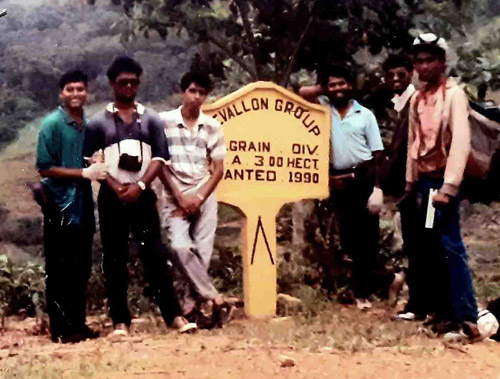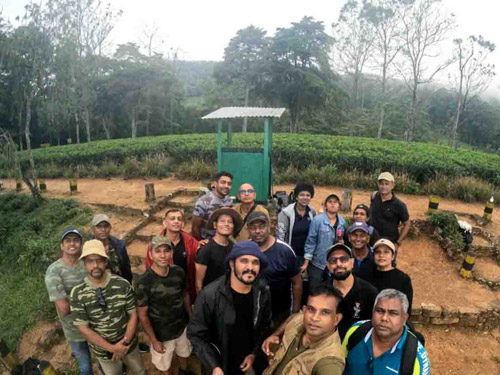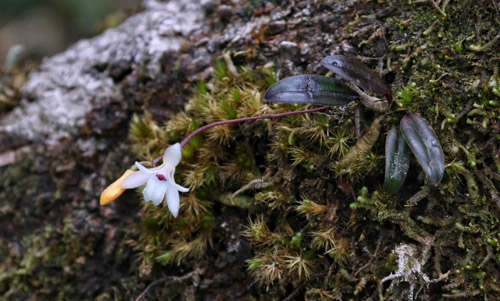Rediscovering Loolekandura

The first group: (L-r) Kumudu Amerasinghe, Kolitha Senanayake, Susantha Amarasooriya, Ajith Madadeniya, Mangala Ranasinghe, Kapila Dissanayake, and below, the group that made the hike recently from Deltota to Loolekandura
Sri Lanka is known as a biodiversity hot spot, thanks to its diverse forest vegetation, varied ecosystems, distinctive topographical features and rich landscapes. Loolekandura, especially the Kondagala area within the Galaha forest reserve, plays a crucial role in this biodiversity.
This region is home to the rare mid-elevational Lower Montane wet evergreen forests, unique for their specific species composition. These forests thrive in the 900-1400 metre range across Sri Lanka’s three main mountain massifs: the Central Hills, Rakwana Hills, and Knuckles. Loolekandura, located in the Central Hills, exemplifies this rare forest type.
What makes Loolekandura (in Sinhala ‘the stream full of loola fish’ – Channa striata) truly special is its mixed vegetation, which includes species from montane, wet lowland, and dry zone forests. This exceptional blend encompasses nearly all of
Sri Lanka’s major forest types.
My connection to Loolekandura began over 30 years ago with an unforgettable adventure as a young explorer when in September 1992, as a team from the Youth Exploration Society of Sri Lanka based at the Royal Botanic Gardens, Peradeniya, we embarked on our first long-distance trekking expedition.
 Starting from Hanthana mountain, we aimed to reach Pidurutalagala and Horton Plains, exploring the rich heritage of hill country’s flora and fauna and advocating for the preservation of these valuable resources.
Starting from Hanthana mountain, we aimed to reach Pidurutalagala and Horton Plains, exploring the rich heritage of hill country’s flora and fauna and advocating for the preservation of these valuable resources.
Many mountain tops in the hill country’s tea plantations remain covered in natural forests, crucial for biodiversity and hydrology. Our goal was to raise awareness among the estate community about the importance of these forests.
A highlight of our journey was the unexpected discovery of Loolekandura,
Sri Lanka’s first tea estate, established by Scottish planter James Taylor in 1867 (he called it Loolecondera). Lost in the dense bamboo cover of Galaha forest reserve, we stumbled upon the tea plantation, unaware that it was Loolekandura.
The steep slopes and nightfall complicated our descent, but we eventually made camp at the forest edge after descending along a waterfall. Mistaken for intruders, we were surrounded at midnight by police and locals armed with clubs and billhooks. Thankfully, the situation was resolved amicably, and they even offered their assistance.
Our Seven Day Expedition, as it came to be known, took a week to complete. We repeated this trek in 1995, 1998, 2001, 2005, and 2010, exploring various routes including Muloya, Hope, Protoft, the Chariot Path, the horse trail from Rookwood to Top Pass, Nuwara Eliya, Nanu Oya, Uvakelle, Wellikelle, Elgin, Dayagama, Horton Plains, and Balangoda.
A programme to revisit our first long-distance trekking expedition was recently held at Loolekandura and included a short hike from Deltota to Loolekandura, to highlight Loolekandura’s unforgettable significance in our expeditions.

Adrorhizon purpurascens: An endemic epiphytic orchid. Pic by Shaveen Madushka
Searching for an ideal partner? Find your soul mate on Hitad.lk, Sri Lanka's favourite marriage proposals page. With Hitad.lk matrimonial advertisements you have access to thousands of ads from potential suitors who are looking for someone just like you.


